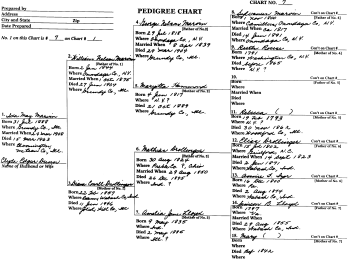Pedigree or Family Tree Charts
Pedigree or Family Tree Charts
The family tree form you begin with is a pedigree chart, an ascendant chart. On it you start with yourself and work back in time, generation by generation, filling in your parents, grandparents, great-grandparents, and so on, as far back as you can.
Genie Jargon
A pedigree chart starts with you and shows the line of your direct ancestors. It is sometimes called a family tree, lineage, or ancestry chart.
Think of the pedigree chart as a shorthand master outline of your bloodline. A quick glance at it alerts you to the blank spots in the information you are gathering. This in turn helps you develop your research plan. When you notice that Great-Grandma Diana's maiden name is blank or that there is no marriage date or place for Grandpa Guy, you have a clear picture of the information you still need.
The format of a pedigree chart is always the same: your name (or the individual whose ancestry you are tracing) is on the first line, your father's name (or the subject's father's name) is on the upper line, your mother's on the lower line. The upper track in a pedigree chart is that of the father's (paternal) line. The lower track is the ancestral line for the mother's (maternal) line. You are number 1 on this chart. Your father is assigned number 2 and your mother number 3. On a pedigree chart the numbers for men are always even numbers, and the numbers for women are odd.
Pedigree Pitfalls
Pedigree charts have no space for source citation. Therefore, they should not be disseminated unless accompanied by an attached sheet with full citations keyed to the information on the chart, or a family group sheet, which does have citations.
As you can see, you quickly run out of space for all your ancestors on a four-generation chart. To list the additional generations, you must create additional charts.
In numbering the pedigree chart, you are number 1 on chart 1. One of your great-grandfathers is number 8 on chart 1. You will need to make a new chart to continue with his ancestors. That great-grandfather (who is number 8 on chart 1) will become number 1 on chart 2. Be sure to make a reference on chart 2 that he is also number 8 on chart 1, so you can easily follow the line in connected charts.

Large or Small, They Chart Your Family
Blank pedigree charts accommodating 4 to 15 generations can be purchased. The four-generation pedigree chart is the most convenient to work with in your day-to-day research. The more generations on the chart, the less room there is for data about individuals.
Some decorative pedigree charts are suitable for framing. They can be fan shaped with the lines radiating out from you at the center. Some are in the form of a tree with limbs and branches representing family lines. Still others have spaces for photographs. Although attractive as wall art, these charts are too large to be useful as research aids.
Filling in the Pedigree Chart
Completely fill in as many of the spaces on the pedigree chart as you can. If you know an individual's middle name, write it out rather than use the initial. Put nicknames in quotation marks after the given name. Use women's maiden names, and if they are not known, use a blank parenthesis, such as ( ). When known, geographic places should indicate the town or township, county, and state. Write the dates with the day first, the month written out next, and all four digits for the year.
Because the pedigree chart is an instant guide to your research, keep it up-to-date so that you can follow the clues. Add new information as you find it, and correct the information as you uncover errors.
Pedigree charts cannot stand alone as evidence of your ancestors. They are research tools, not the end result of your research. Consider the pedigree charts as notes to yourself that show at a glance where you are in your pursuit of your family history.